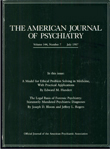The objectives of the first edition of this book (1990) remain—“to provide the practising psychiatrist with information about physical therapies in his specialty and with guidelines about how to use them,” while designed to be of particular relevance to psychiatrists in training. The breadth of the book is ambitious (for two authors) but is realized and assisted by a generally congruent style.
The contents meld information and clinical wisdom with the tone of an avuncular mentor who retains a healthy level of skepticism about his own favored discipline. The reader is informed immediately that the major drug discoveries were, by and large, “lucky accidents,” is advised to be aware of our ignorance in therapeutics, and cautioned that, in psychopharmacology, the rule of thirds operates (“In a third of psychopharmacology, drug efficacy is difficult to establish because of drug resistance, in a third because of natural remission/placebo response, and in a third because of both.”) Again, in noting the “increasingly artificial conditions of controlled clinical trials,” the authors effectively warn us about the risks of the double-blind leading the blind.
Early chapters lucidly cover principles of treatment, neuropharmacology, behavioral studies, biological mechanisms underpinning the major disorders, pharmacokinetics, treatment evaluation (with particular elegance and with useful historical references), and social aspects of prescribing (here the authors make the point that there is “no need to rush in with drug treatment in the vast majority of patients”). Then the principal groups of psychotropic drugs (and their applications and clinical nuances) are reviewed usefully. However, publishing delays have clearly prevented the inclusion of much information on newer antidepressants and atypical antipsychotic drugs (and their comparative properties).
In addition to covering the major psychiatric disorders, the authors consider sleep disorders, drug treatment in children and the elderly, psychosurgery, and ECT (again publishing delays prevented review of more recent monitoring procedures and technical components such as stimulus dosing).
This edition meets its objectives and can be strongly recommended as an excellent overview of the field for trainees and for providing true “expert opinion.” Here the experts deliver a high-quality product, clearly personalized, and without ever referring directly to “evidence-based psychiatry,” marking out what they describe in another context as the “commanding heights of the therapeutic landscape.”

